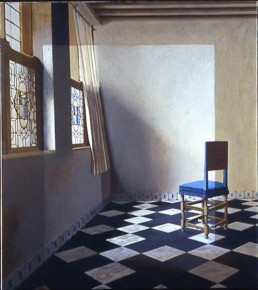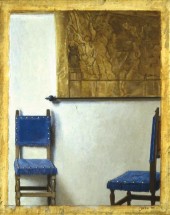| WorkExtended Vermeer
| Image Notes
Reference
Vermeer, Lady Writing a Letter with Her Maid, 1670-72, National Gallery of Ireland, Dublin. The ceiling is from Vermeer's The Music Lesson, 1662-64, The Royal Collection, London. In Extended Vermeer the shadow of the window-wall inhabits the bright reflection coming as if from a door opening. Shadow and light extend the space of the painting. The blue-upholstered chair is waiting for someone bold enough to sit in light and shade, willing to let the shadow of the past be cast over him so that he can in turn illuminate the presence of the past. That chair: Deem's self-portrait. (Mieke Bal, Exhibition brochure announcement Pavel Zoubok Gallery, New York, March-April 2002). In a work that distills (Vermeer's) studio to its essence, Extended Vermeer (2000), an empty chair faces a corner where a breeze lifts the curtain at the far end of the wall. A rectangle of light, introduced by the opening of some large and unseen door in the viewer's space, illuminates the reductive painting. That light, Deem implies in homage, may have been Vermeer's principal subject after all. (Edward Leffingwell "George Deem at Pavel Zoubok" Art in America, July 2002). In Extended Vermeer (2000) Deem creates a highly refined image, which, as its title implies, begins with a specific Vermeer painting and extends it. Deem's work here focuses fully on the interior space of a room, with a chair and simple curtain hanging from the far window being the only non-architectural elements included (fig. 36). Although at first glance a connoisseur of Vermeer might interpret Deem's painting as the precise space from a specific work by the artist, when considering Extended Vermeer more carefully, one can see this is not fully the case. The central core of Deem's painting, indeed, represents the room environment of Vermeer's Lady Writing a Letter with Her Maid where its contents have been emptied save a chair and curtain. Deem literally highlights the space taken from this orginal painting by Vermeer by superimposing a perfect rectangle at his own painting's core that is clear and masterfully defined through subtle modulations of color. The resulting slightly darkened outer margins of the painting thus serve to precisely inform the viewer of where Vermeer's constructed reality ends and Deem's imagined spatial extension begins. The ceiling and closest window in Deem's work are traceable to Vermeer's The Music Lesson; however, his elaboration on these elements is fully his own. While in its clarity and definition Deem's emphasis on the rectangle begs comparison with the paintings of other modern artists including, for example, Josef Albers. The use of light and dark in Vermeer Extended also offers a brilliant visual metaphor for the fundamental reality of Vermeer Studies. All we really know about Vermeer is found in his paintings; the rest, at present, is shrouded in shadow and can really only be speculated about or imagined. (Marguerite Anne Glass, Vermeer In Dialogue: From Appropriation To Response PhD Dissertation, 2003, Department of American Studies, University of Maryland drum.lib.umd.edu/bitstream/1903/45/1/dissertation.pdf) The source of this painting (Extended Vermeer) is Vermeer's Lady Writing a Letter with Her Maid (ca. 1670; National Gallery of Ireland, Dublin). Characteristically, Deem vacated Vermeer's room, stripped it of most of its furnishings, and then, by taking a longer view of the space than had Vermeer, imagined parts of it that are not visible in the original. This extension is clearly indicated by the shaded area, leaving Vermeer's space, painted at the scale of the original, intact. As it was for Vermeer, Deem's real subject here is light.(David Dearinger, exhibition wall text,George Deem: The Art of Art History, The Boston Athenaeum, April 11 - September 1, 2012). | ExhibitionsYale University Jonathan Edwards College Master's House
The Boston Athenaeum, Boston, Massachusetts
Pavel Zoubok Gallery, New York
|
| WorkExtended Vermeer
| Image Notes| Exhibitions |







